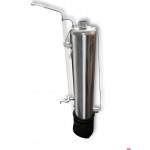
Hydraulic Testing of the Autoclave
The production of autoclaves is a process that requires several levels of checks and tests before the autoclave is sent to the customer. One of the most important characteristics of an autoclave is its airtightness. Considering that pressure is created inside the autoclave, the unit must be ready for emergency situations. In this article, we will discuss the hydraulic testing of our "A" series autoclave.
The tests were conducted at the E.O. Paton Electric Welding Institute of the National Academy of Sciences of Ukraine. The purpose of these tests is to demonstrate the behavior of a household autoclave under various conditions and to push the unit to its breaking point.
Operation of the Autoclave with a Safety Valve
At the first stage, we want to demonstrate how the safety valve of the household autoclave works. The working pressure during autoclaving in our unit is 4-4.5 atm. The safety valve activates at a pressure of 6 atm. Therefore, at this stage of testing, we will create a pressure in the autoclave above 6 atm to check and ensure the functionality and reliability of the safety valve.
We have tested the explosion valve many times, and in each test, it has shown excellent results. We confirmed that at a pressure of 6 atm, the valve begins to open smoothly, and consequently, it fully opens after 6.4 atm.
Operation of the Autoclave without a Safety Valve
The result of the previous test showed that the safety valve effectively and clearly performs its functions. We proceed to the next stage of verification, specifically, we removed the valve and replaced it with a plug. Now nothing prevents us from raising the pressure in the autoclave above 6 atm.
Now we raised the pressure in the autoclave to 12 atm, which is twice the emergency pressure of 6 atm and three times the working pressure. In the video, you can see that even at such high pressure, the autoclave continues to operate steadily; it easily withstands such a high load. Only the manometer, which is rated for 6 atm, was damaged. After reaching 12 atm, the needle on the manometer returned to its starting position, but it went down not to 0, but to 2 atm.
However, we decided not to stop there and continued the experiment, increasing the pressure to 24 atm. After reaching a pressure of 24 atm in the autoclave, something very important happened—the pressure forced out the rubber seal, and water leaked at that point, after which the rubber was pulled back in. This is a very important result, showing us that the seal acted in this case as a "second safety valve" and prevented the unit from raising the pressure above 24 atm. At the same time, the rubber was not damaged at all and returned to its original state.
After this stage of testing, we observed the first deformations in the structure. The bottom and the flange with the lid were most affected; they were bent between the connecting bolts, leading to the rubber being forced out.
Operation of the Autoclave Using Pressure Plates
We decided not to stop at 24 atm but to continue. To do this, we added pressure plates to the lid's design.
Thanks to this, we achieved a pressure of 26 atm. The plates helped, but not significantly. At a pressure of 26 atm, the same thing happened as in the previous test—the rubber seal was forced out, leading to a pressure drop, and the rubber was pulled back in.
To further increase the pressure, we decided to increase the number of fastening bolts from 6 to 12, thereby preventing the rubber from being forced out. Thanks to this, we managed to raise the pressure to 31 atm. At this pressure, localized destruction of the weld occurred, leading to water leaking from the tank. The high load caused evident deformation of the body, but critical destruction did not occur.
This was the final stage of the test. We still could not blow up our autoclave or bring it to critical damage. The autoclave body and its components withstood a load 5 times higher than the emergency load and 7.5 times higher than the working load. All components remained physically intact and withstood the load. The heating element also withstood the load of 31 atm and continued to function correctly and provide heating.
Such tests once again prove that the autoclaves from the company "Ukrpromteh" are manufactured in compliance with all standards and are safe to use. Order a household autoclave on our website.
Read also:
- Autoclave Operating Modes
- What is an Autoclave
- Hydraulic Testing of the Autoclave
- How to Use an Autoclave
- How to Choose an Autoclave









